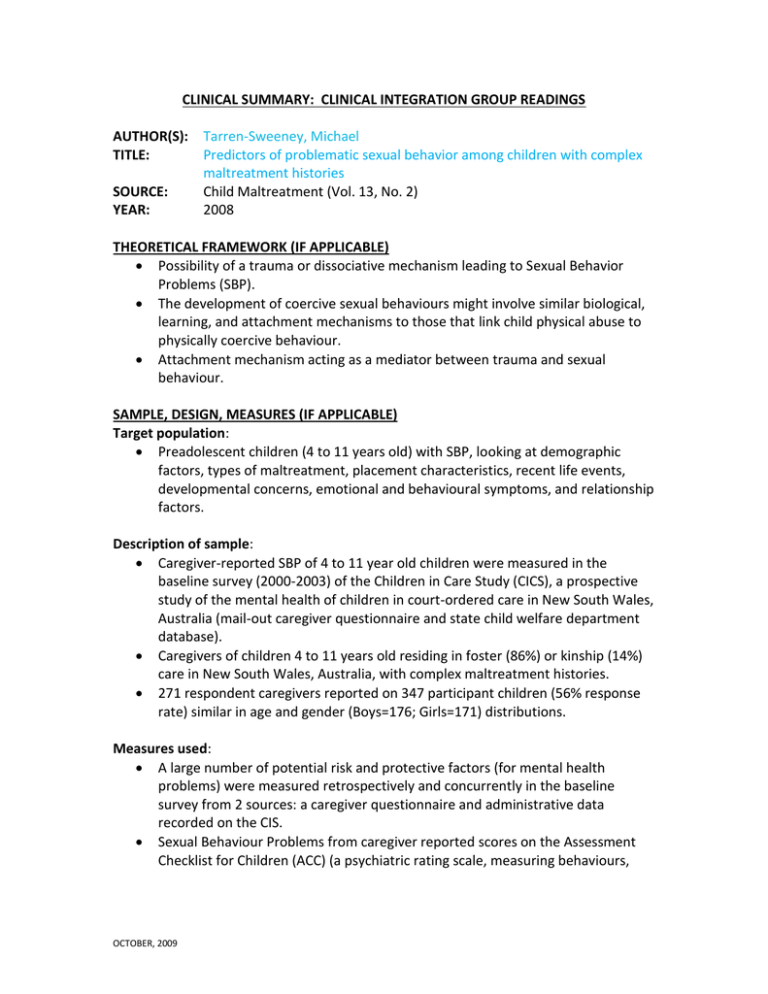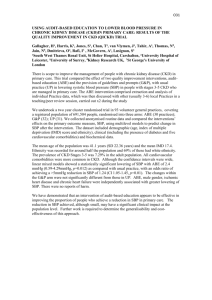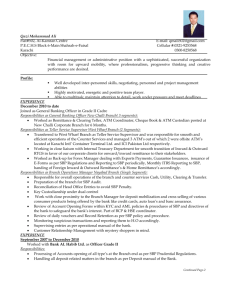CLINICAL SUMMARY: CLINICAL INTEGRATION GROUP READINGS AUTHOR(S): TITLE:
advertisement

CLINICAL SUMMARY: CLINICAL INTEGRATION GROUP READINGS AUTHOR(S): TITLE: SOURCE: YEAR: Tarren-Sweeney, Michael Predictors of problematic sexual behavior among children with complex maltreatment histories Child Maltreatment (Vol. 13, No. 2) 2008 THEORETICAL FRAMEWORK (IF APPLICABLE) Possibility of a trauma or dissociative mechanism leading to Sexual Behavior Problems (SBP). The development of coercive sexual behaviours might involve similar biological, learning, and attachment mechanisms to those that link child physical abuse to physically coercive behaviour. Attachment mechanism acting as a mediator between trauma and sexual behaviour. SAMPLE, DESIGN, MEASURES (IF APPLICABLE) Target population: Preadolescent children (4 to 11 years old) with SBP, looking at demographic factors, types of maltreatment, placement characteristics, recent life events, developmental concerns, emotional and behavioural symptoms, and relationship factors. Description of sample: Caregiver-reported SBP of 4 to 11 year old children were measured in the baseline survey (2000-2003) of the Children in Care Study (CICS), a prospective study of the mental health of children in court-ordered care in New South Wales, Australia (mail-out caregiver questionnaire and state child welfare department database). Caregivers of children 4 to 11 years old residing in foster (86%) or kinship (14%) care in New South Wales, Australia, with complex maltreatment histories. 271 respondent caregivers reported on 347 participant children (56% response rate) similar in age and gender (Boys=176; Girls=171) distributions. Measures used: A large number of potential risk and protective factors (for mental health problems) were measured retrospectively and concurrently in the baseline survey from 2 sources: a caregiver questionnaire and administrative data recorded on the CIS. Sexual Behaviour Problems from caregiver reported scores on the Assessment Checklist for Children (ACC) (a psychiatric rating scale, measuring behaviours, OCTOBER, 2009 emotional states, traits, and manners of relating to others, as manifested by children in care) SUMMARY / MAJOR FINDINGS / THEMES Almost all children with SBP had corresponding psychopathology, most notably conduct problems, inattention, and interpersonal behaviour problems suggestive of attachment disturbances. Findings emphasize the significance of cumulative risk among children exposed to multiple adversities. 1/3 of the children were reported as manifesting at least some problematic sexual behavior (2/3 of subject children scored zero on the SBP scale). High rate of concordance for the presence (n=39) versus absence (n=13) of any SBP among 52 sibling dyads (75%). Among the 39 concordant pairs, 27 were concordant for absence and 12 were concordant for presence of SBP. Factors that were strongly associated with SBP scores included/independent predictors of SBP: o Children’s age at entry into care o Their estimated length of time exposed to maltreatment o The ratio of time in present placement/time in care (a measure of placement stability) o Several measures of care status and permanency; and, o Confirmed exposure to contact sexual abuse. Factors NOT associated with SBP scores were o Type of care (kinship versus foster care) o Reported intellectual disability o Noncontact sexual abuse; and, o Most other forms of abuse and neglect (including physical abuse and witnessing parental violence). 4 independent predictors of SBP: o Older age at entry into care o Contact sexual abuse o Female gender (scored higher than boys) o Lower ratio of time in present placement/time in care (a measure of placement stability) CLINICAL IMPLICATIONS / RELEVANCE TO PRACTICE Cumulative exposure to adversity o Aside from contact sexual abuse, no specific form of abuse or neglect predicted children’s SBP. o The only other maltreatment variable associated with children’s SBP continuous scores was the time between their first confirmed notification and their entry into care, which is perhaps a crude indicator of cumulative exposure to adversity (older children were more likely to have OCTOBER, 2009 entered care later with greater cumulative exposure to adversity and/or children in care often first disclose pre-care sexual abuse many years after entering care). o Several factors previously identified as correlates of SBP were not associated with SBP scores in the present sample, notably physical abuse and witnessing parental violence. Do attachment difficulties contribute to the development of SBP? Present findings provide some empirical support for a proximal relationship between attachment and SBP. o Inhibited form of reactive attachment disorder: Low empathy in the context of attachment disturbance may contribute to the development of SBP among high-risk children o Disinhibited form of reactive attachment disorder: could be manifested as sexually indiscriminate: in the absence of meaningful attachments, such children might have difficulty in discriminating between non-sexual and sexualized affection, especially so if they have been sexually abused. Pseudomaturity and associated role reversal has been previously linked to SBP. (Present findings only provide limited support for this hypothesis). STRENGTHS AND LIMITATIONS OF THE STUDY/READING Strengths: Retrospective data recorded close to the time of the events (less prone to recall bias than self-reported data). Comprehensive child welfare and alternate care records for each child. Limitations: The study sample under-represents children placed at an early age in stable, long-term, “adoptive-type” placements who display less mental health problems: survey slightly overestimates the prevalence of mental health problems in the study population. Exploratory: Focus on hypothesis generation rather than hypothesis testing. OCTOBER, 2009


